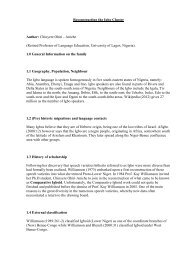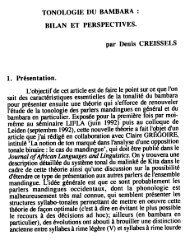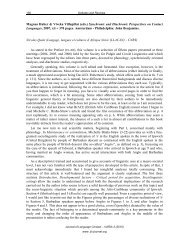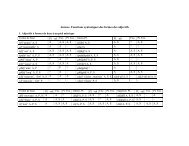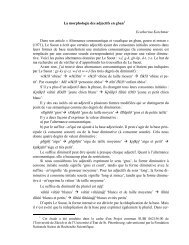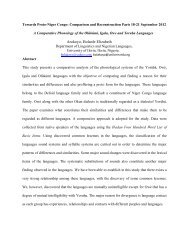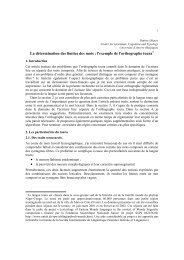1 A LINGUIST'S FIELD NOTES INTRODUCTION ... - Llacan - CNRS
1 A LINGUIST'S FIELD NOTES INTRODUCTION ... - Llacan - CNRS
1 A LINGUIST'S FIELD NOTES INTRODUCTION ... - Llacan - CNRS
You also want an ePaper? Increase the reach of your titles
YUMPU automatically turns print PDFs into web optimized ePapers that Google loves.
(1) ka ɬíí yáà?<br />
thou + Future leave question<br />
Are you going to leave?<br />
(2) myáá súú, ma ɬíí<br />
I + Unf. Con. want I + Fut. leave<br />
myáá súú hŋ, ma ɬâŋ.<br />
I + Unf. Con. want Neg. I + Fut leave + Neg.<br />
If I want, I’ll leave ; if I don’t want, I won’t leave.<br />
One can find the morpheme ʃèè invariable whatever may be the tense, aspect or<br />
mood, or the person and number of the subject :<br />
(3) á wû tu kyáàn ʃèè fim zàmba<br />
he + Narrative say that you SHE do + me trick<br />
He said, it is you who have deceived me.<br />
where ʃèè replaces kə, that is to say ;<br />
(4) ʃèè yelí ŋáà?<br />
SHE see + Perfect Question<br />
You have understood, haven’t you?<br />
where ʃèè replaces káá, that is to say ;<br />
(5) ʃèè lə́ə́r volaŋ ɗi,<br />
SHE carry groundnuts here<br />
ʃèè ndəər də̀n wò kəń<br />
SHE shell house your only<br />
If I bring you groundnuts, you will have to shell them at your house.<br />
where the first ʃèè replaces myáá, that is to say , and the second<br />
replaces ka, that is .<br />
The absence of grammatical gender, added to this obliteration of aspect and tense<br />
markers, gives these Zaar tales and fables a very special tonality. 12<br />
12 What I assumed to be a new tense used in tales appeared, on closer look, to be the imitation of a speech<br />
impediment characterizing the hyena, and is not to be found anywhere else in the corpus. [note added in 2002]<br />
40


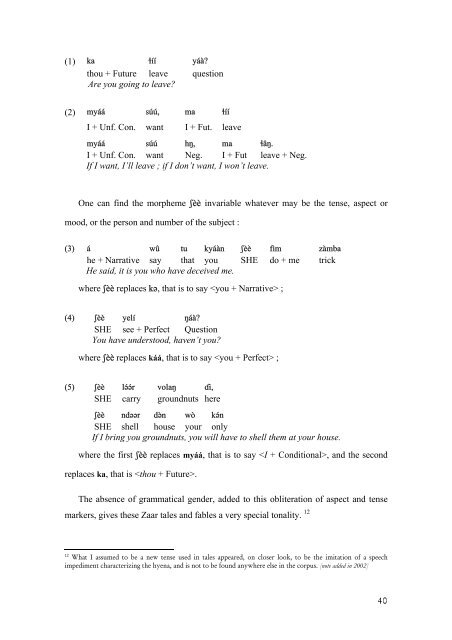
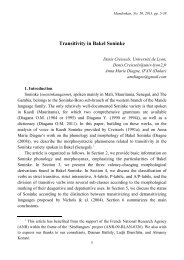
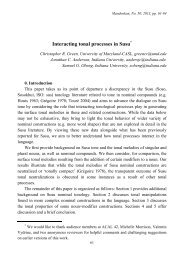
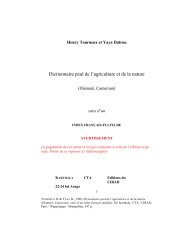
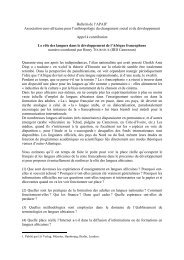

![[halshs-00645129, v1] Depressor consonants in Geji - Llacan - CNRS](https://img.yumpu.com/17832391/1/190x245/halshs-00645129-v1-depressor-consonants-in-geji-llacan-cnrs.jpg?quality=85)
